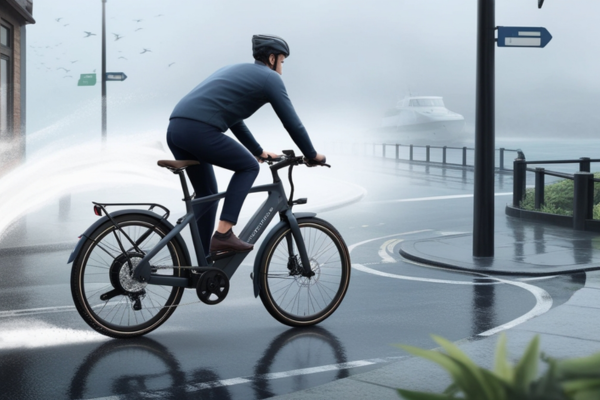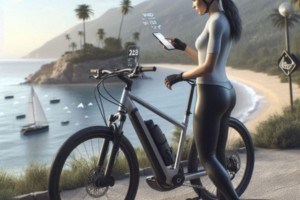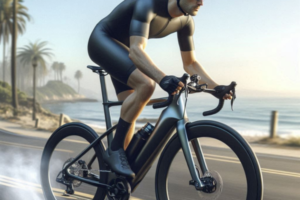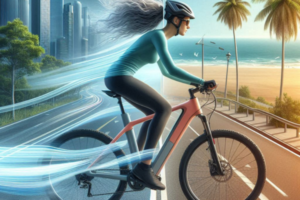Humidity wind resistance electric bicycles—these four words define an invisible battle faced daily by coastal riders. It’s not just about puddles, fog, or salt—it’s about how the very air becomes thicker, heavier, and harder to cut through. If you’ve ever pedaled along a seaside boulevard and felt your motor working harder than usual, you’ve experienced it firsthand. 🌬️🚴♀️
In humid environments, every ride becomes an aerodynamic challenge. Moisture-saturated air behaves differently—it clings to surfaces, alters flow dynamics, and creates subtle drag that quietly drains your battery. Riders may not notice at first, but over time, they begin to feel it: reduced speed, higher energy use, and a sense of constant resistance. The culprit? A perfect storm of moisture, wind, and inadequate preparation. 💧🔋
🌫️ Understanding Humidity Wind Resistance in Electric Bicycles
When air is humid, it holds a higher concentration of water vapor. This means that each cubic meter of atmosphere has more molecules sticking to every surface your e-bike exposes: handlebars, panniers, helmets, even your clothing. These molecules form microfilms of moisture that disrupt what aerodynamicists call laminar flow—the smooth movement of air across a surface. Instead, you get turbulent flow: swirling pockets of low pressure that cling and drag. The result is invisible resistance that builds with speed and moisture. 🌀
Electric bicycles are especially vulnerable. Unlike racing bikes designed for aerodynamics, most e-bikes feature bulky battery enclosures, upright frames, and visible cables. Add coastal humidity into the mix, and you create a machine that constantly battles wind friction. Every ridge, bolt, or uneven edge becomes a point where moist air clings, slows, and saps energy. 🌊⚡
What makes it more complex is that humid air isn’t denser than dry air—in fact, it’s technically lighter. But it behaves stickier, and that stickiness, combined with coastal winds, creates aerodynamic drag that affects real-world performance. On flat terrain, riders feel more “pushback.” On inclines, motors heat up faster. Batteries deplete not because you’re going faster—but because the air is working harder against you. 🌬️🔋
💬 Case Highlight: “My usual route from Playa Azul to the tech hub is just 16 km. But during foggy mornings, I lose almost 20% more battery. After installing fender deflectors and switching to a tighter riding jersey, I regained 3 kilometers of range.” — Julián, rider in Cartagena.
⚠️ Common Signs of Moisture-Induced Drag
- ⚠️ The motor feels unusually warm early in the ride
- ⚠️ You struggle to maintain speed despite full battery
- ⚠️ Wind noise increases around panniers or handlebars
- ⚠️ Condensation builds up on frame or gear mid-ride
- ⚠️ Your bike feels “sticky” even on clean roads
These symptoms often go misdiagnosed—riders blame terrain or aging batteries. But in coastal cities with over 70% average humidity, they are classic indicators of aerodynamic inefficiency. Left unaddressed, they reduce battery life, slow commute times, and gradually wear down your motor and your confidence. 💡
The first step is awareness. Once you understand how humidity wind resistance electric bicycles interact, you can begin to counteract the effect with design choices, routine maintenance, and smarter riding posture. And no—you don’t need a wind tunnel or a brand-new bike to do it. You just need insight, intention, and consistency. 🌴🔧
Humidity wind resistance electric bicycles present a challenge that evolves depending on air conditions, terrain, and rider habits. One key element often overlooked is how different weather behaviors—fog, mist, high dew point—transform the aerodynamic environment you move through. When these factors combine, they change not just how fast you go, but how efficiently your e-bike converts energy into motion. 🌫️🔋
What’s happening is subtle: moisture interacts with your bike’s geometry and gear. If your panniers have flat edges, they catch the wind like sails. If your battery housing isn’t streamlined, it creates turbulence. If your riding gear is loose and absorbent, it becomes a moisture magnet. All of these add resistance in humid climates and reduce range, even on flat routes. 🔄🧳
📊 Comparing Aerodynamic Behaviors by Humidity Level
Let’s compare riding conditions across three common scenarios in coastal areas:
| Condition | Typical Humidity | Aerodynamic Impact | Rider Feedback |
|---|---|---|---|
| Dry coastal morning | 50–60% | Minimal drag | Smooth ride, stable power |
| Foggy or misty start | 75–90% | Increased drag zones | Notable resistance, fast drain |
| Post-rain humidity spike | >90% | Heavy drag, reduced flow | Motor warms up quickly |
Understanding these conditions can help you prepare both mentally and mechanically. If you wake up and notice mist on your window, it’s not just a visual cue—it’s a sign that air resistance will be higher during your commute. Planning accordingly could mean preserving 10–20% of your battery range. 🧠⚙️
💡 How to Adapt Your Gear to Moist Coastal Conditions
- ✅ Choose aerodynamic panniers with sloped sides
- ✅ Use water-repellent seat covers and frame wraps
- ✅ Avoid canvas bags—they soak and increase drag
- ✅ Wear moisture-wicking, tight-fitting clothing
- ✅ Seal any cables or protruding hardware
These simple changes can have outsized effects. Many riders in cities like Santa Marta, Cartagena, and Recife report smoother rides just by switching from generic rear baskets to hard-shell panniers. The difference lies in how well air—and water vapor—glides around your equipment. 🌁🎒
🛠️ Quick Tip: Use clear hydrophobic tape along your down tube and fork. It adds no weight, improves airflow, and prevents moisture buildup in problem zones.
It’s clear: in humid cities, adapting your setup is just as important as maintaining your battery or motor. Once you see the wind, moisture, and gear as interconnected, your approach changes. You stop resisting the conditions—and start riding with them. 🌬️🧩
Humidity wind resistance electric bicycles do not require a complete overhaul to ride better—they demand consistent attention to aerodynamic detail. Once you understand that drag in humid conditions comes from moisture interacting with airflow, every choice you make starts to matter: how you sit, how you dress, what bags you attach, and how clean your bike stays. 🌫️🛠️
One of the easiest places to start is with your body position. Riding upright is comfortable, yes—but in coastal environments with thick air, that comfort comes at the cost of resistance. The higher your torso, the more area there is for sticky, heavy air to hit. That resistance feels like fatigue, but it’s actually measurable energy loss. 🧘♂️
✅ Checklist to Reduce Wind Resistance in Humid Environments
- 🟢 Posture: Lean slightly forward and bend your elbows inward
- 🟢 Clothing: Wear snug, moisture-repellent layers—no loose jackets
- 🟢 Helmet: Use one with smooth shell and covered vents
- 🟢 Panniers: Choose aero models with sloped, waterproof sides
- 🟢 Cables: Tuck or tape any external wires or straps
- 🟢 Accessories: Avoid large baskets, flags, or flapping decorations
- 🟢 Footwear: Use shoes that don’t splash or kick up water spray
Many riders report a 5–10% improvement in battery duration just by adjusting posture and switching to aerodynamic panniers. These are small changes with big impact—especially on longer commutes, or when riding into a humid headwind. 💨🔋
🧼 Why Cleanliness is Aerodynamics in Disguise
Humidity encourages dirt to cling. The fine mist that coats your bike on coastal roads combines with dust and salt to form a gritty film. This adds roughness to surfaces that should be smooth. And when surfaces become rough, airflow breaks prematurely, increasing drag. The problem isn’t just aesthetic—it’s energetic. 🌊🧽
Keeping your e-bike clean isn’t just about looking good. It’s about preserving a surface that encourages efficient airflow. After every ride near the ocean, rinse the frame with freshwater, dry thoroughly, and apply a silicone spray or ceramic coating. Weekly chain lubrication with waterproof lube is essential. Salt and humidity are silent destroyers of efficiency. ⚠️🛞
💬 Rider Insight: “After two months riding near the marina, I noticed weird battery drops. Turns out it was drag from dirty cables and wet saddlebags. A five-minute post-ride wipe now adds 4 kilometers to my daily range.” — Elena, Barranquilla commuter
Beyond maintenance, even storage matters. Leaving your bike outdoors overnight near the coast allows moisture to settle and seep into cables and joints. Store your e-bike in a dry, shaded space—or use a breathable waterproof cover. Moisture that sits overnight creates more drag the next day, guaranteed. 🌧️🕔
Whether you’re pedaling down a seaside bike lane or cutting through inland humidity after a storm, your bike’s performance is in your hands. Mastering humidity wind resistance electric bicycles isn’t about chasing perfection—it’s about removing the tiny barriers that slow you down, little by little, every ride. ✨🚴♀️
Humidity wind resistance electric bicycles are not just a short-term challenge—they require a long-term mindset. If you live near the coast or ride frequently through humid air, then it’s time to think beyond temporary fixes and start building a system that thrives in wet, dense conditions. 🌧️💡
It all starts with your frame and components. Many e-bikes are designed for versatility, not for cutting through moist air. They’re functional but not necessarily aerodynamic. Over time, choosing components that minimize drag and resist corrosion makes a massive difference in your battery range, comfort, and ride longevity. 🛠️⚙️
🏗️ Choosing the Right Materials for Humid Coastal Conditions
When it comes to fighting wind resistance in wet climates, the materials that make up your bike matter more than most people realize. Below is a comparison of the most common frame types and their suitability for humid environments:
| Material | Aerodynamic Potential | Humidity Resistance | Maintenance Needs |
|---|---|---|---|
| Carbon Fiber | Excellent | High | Low |
| Aluminum (Anodized) | Good | Moderate | Medium |
| Steel | Low | Low | High |
If you’re riding year-round near the sea, carbon fiber offers both corrosion resistance and aerodynamic form. Aluminum is more affordable and performs well when coated properly, but it requires regular checks for oxidation. Steel, although strong, is not ideal unless it’s part of a retro or low-speed utility build. 🔍🧱
🔧 Other Smart Upgrades for Long-Term Efficiency
- 🔩 Stainless steel fasteners: Replace standard bolts with rust-resistant ones
- 🔗 Sealed wheel bearings: Prevent moisture intrusion and friction buildup
- 🧼 Hydrophobic spray coating: Protect frame, battery case, and fork
- 🎒 Aerodynamic panniers: Reduce surface disruption during wet rides
- ⚙️ Covered drivetrain systems: Protect gears from moisture and salt
💬 Upgrade Story: “Switching to carbon wheels and sealed bearings cut my energy use on coastal climbs. It’s not just about saving watts—it’s about making the ride feel smooth again.” — Miguel, triathlete in Santa Marta
When you make these upgrades, you’re not just improving performance—you’re removing silent resistance. Every cable that doesn’t flap, every bolt that doesn’t rust, and every bag that doesn’t balloon with wind is part of a bigger system working with the environment instead of against it. 💨🌴
Remember, humidity wind resistance electric bicycles don’t require you to change bikes—they require you to refine the one you have. Over time, these improvements compound: better posture meets better materials, smarter storage meets better protection, and a smoother ride becomes your new normal. 🧩🌟
Humidity wind resistance electric bicycles are not an obstacle—they’re an opportunity. An opportunity to learn, adapt, and transform your ride. Coastal environments are demanding, but they also invite us to rethink how we move through air, how we maintain our bikes, and how we care for our riding experience. 🌬️🚲
With every practical change—from posture to protective coating—you reduce invisible drag. You conserve battery. You move faster with less effort. But more importantly, you ride with confidence knowing your e-bike is adapted to the elements, not at war with them. 🌊🔋
🔁 Final Checklist to Maximize Your Ride
- ✅ Maintain a forward-leaning, compact posture
- ✅ Use moisture-wicking, fitted riding apparel
- ✅ Clean and dry your bike after each coastal ride
- ✅ Apply silicone or ceramic spray weekly
- ✅ Upgrade to rust-proof bolts and sealed bearings
- ✅ Choose aerodynamic, waterproof panniers
- ✅ Store your e-bike in a dry, ventilated space
By following these practices consistently, your e-bike becomes a tailored machine—not just for speed, but for survival in the elements. And that’s where real sustainability lives: in durability, not just design. 💡⚙️
🌟 Thought to Ride With: “We don’t always choose the weather, but we can choose how we move through it. Intelligence, preparation, and community turn resistance into rhythm.”
❓ Frequently Asked Questions (FAQs)
Does humidity really affect battery range on e-bikes?
Yes. Moist air disrupts airflow, increases drag, and forces the motor to use more power to maintain the same speed—especially in coastal cities.
What is the best low-cost way to reduce wind resistance?
Adjusting your posture and switching to fitted, water-resistant gear can provide immediate aerodynamic improvement.
How often should I clean my e-bike if I ride near the coast?
After every ride. Salt and moisture combine to create drag and corrosion. A light rinse and dry can prevent long-term performance loss.
Are aerodynamic accessories worth the investment?
Yes. Tapered panniers, covered helmets, and smooth-surface racks reduce turbulent airflow and save battery over time.
Is ceramic coating better than silicone spray?
Both help reduce surface friction, but ceramic coatings last longer and offer better long-term protection in very humid environments.
💙 Join the Coastal E-Bike Community
You’re not alone on the road—or in this learning curve. Riders across coastal cities are sharing solutions, hacks, and stories that help us all get better. From Santa Marta to San Diego, we’re pedaling together through humidity, headwinds, and hope. 🌎🌴
Leave a comment. Tell us what gear works for you. Share your favorite maintenance product. Or just say where you’re riding from—we’d love to hear from you. 🚴♀️💬
📣 Community Call: What’s the one upgrade or habit that made your ride smoother in humid wind? Drop your tip below—it might just transform someone else’s next commute.
Thank you for being part of this journey. 💙 Keep riding strong, keep learning, and may every breeze be in your favor—even the humid ones. 🌬️🚴♂️



